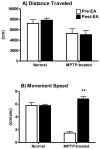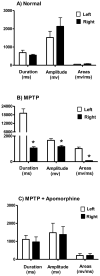Improved methods for electroacupuncture and electromyographic recordings in normal and parkinsonian rhesus monkeys
- PMID: 20654649
- PMCID: PMC2942968
- DOI: 10.1016/j.jneumeth.2010.07.016
Improved methods for electroacupuncture and electromyographic recordings in normal and parkinsonian rhesus monkeys
Abstract
Although acupuncture has been widely and routinely used in healthcare in the USA, its use has been based more on empirical observation than on scientific knowledge. Therefore, there is a great need for better understanding the underlying mechanism(s) of action. A great body of evidence supports that nonhuman primates are a candidate for studying human diseases. However, the use of nonhuman primates in neurophysiological, neuroimaging and neurochemical studies is extremely challenging, especially under fully conscious, alert conditions. In the present study, we developed a protocol for safely performing acupuncture, electroacupuncture (EA) and electromyography (EMG) in both normal nonhuman primates and animals with parkinsonian-like symptoms. Four normal and four hemiparkinsonian middle-aged rhesus monkeys were extensively trained, behaviorally monitored, and received both EA and EMG for several months. The results demonstrated that (1) all rhesus monkeys used in the study could be trained for procedures including EA and EMG; (2) all animals tolerated the procedures involving needle/electrode insertion; (3) EA procedures used in the study did not adversely alter the animal's locomotor activities; rather, MPTP-treated animals showed a significant improvement in movement speed; and (4) EMG detected significant differences in muscle activity between the arms with and without MPTP-induced rigidity. Our results support that rhesus monkeys can be used as an experimental animal model to study EA and that EMG has the potential to be used to objectively assess the effects of antiparkinsonian therapies. The results also indicate that animals, especially those with parkinsonian-like symptoms, could benefit from long-term EA stimulations.
Copyright © 2010 Elsevier B.V. All rights reserved.
Figures





References
-
- Ai Y, Markesbery W, Zhang Z, Grondin R, Elseberry D, Gerhardt GA, Gash DM. Intraputamenal infusion of GDNF in aged rhesus monkeys: distribution and dopaminergic effects. J Comp Neurol. 2003;461(2):250–61. - PubMed
-
- Andersen AH, Zhang Z, Zhang M, Gash DM, Avison MJ. Age-associated changes in rhesus CNS composition identified by MRI. Brain Res. 1999;829(1–2):90–8. - PubMed
-
- Andersen AH, Zhang Z, Barber T, Rayens WS, Zhang J, Grondin R, Hardy P, Gerhardt GA, Gash DM. Functional MRI studies in awake rhesus monkeys: methodological and analytical strategies. J Neurosci Methods. 2002;118(2):141–52. - PubMed
-
- Boonstra TA, Van der Kooij H, Munneke M, Bloem BR. Gait disorders and balance disturbances in Parkinson’s disease: clinical update and pathophysiology. Curr Opin Neuro. 2008;21(4):461–71. - PubMed
-
- Cameron JL, Rockcastle N, Zigmond MJ, Leak RK, Smith A, Lopresti BJ, Mathis CA, Mirnics K, Williams NI, Zhang Z. Exercise protects the striatum against MPTP damage in nonhuman primates. Program 430.7/13. 2009 Neuroscience Meeting Planner; Chicago, IL: Society for Neuroscience; 2009. Online.
Publication types
MeSH terms
Grants and funding
LinkOut - more resources
Full Text Sources

